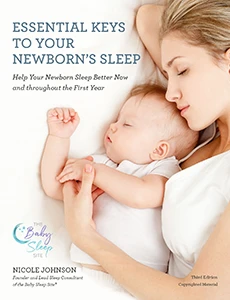
We’ve written quite a bit about baby and toddler naps here on the blog. If you’ve been following our site for a while, you’ve had the chance to read a lot of baby and toddler nap tips and tidbits. But, some of you are new moms or new to The Baby Sleep Site! We strive to educate all of our parents on the importance of good sleep and how to achieve it!
Today, we’re presenting you with 10 must-know facts about your baby’s or toddler’s naps. Think of it as your nap “cheat sheet”. 😉
10 Things You Need To Know About Baby and Toddler Naps
-
- The first nap of the day is the most important. This isn’t to say that other naps aren’t also important. But the first nap of the day tends to be the most restorative, setting the tone for the day, and it’s generally the one that produces the best sleep for babies and young toddlers.
- Most babies don’t transition to one nap at 12 months. Most transition to one nap between 15-18 months. There seems to be a prevailing opinion out there that at the one year mark, babies should suddenly transition from two naps to one. And some will, with no problem. But we’re here to tell you that making the 2-to-1 nap transition at 12 months isn’t the norm for most babies. In fact, most babies aren’t ready to move to one nap a day until 15-18 months.
- Most 6 month old babies aren’t ready for just 2 naps per dayost still need 3 (or even 4). Just as there’s a misconception that all 12 month old babies are ready to transition to one nap per day, there’s also a misconception that 6 month old babies are ready to transition to just 2 naps each day. We think this misconception is at least partly due to a recommendation that Weissbluth makes in his book Healthy Sleep Habits, Happy Child. In the book, Weissbluth states that only 16% of babies need a third nap after 5 months. Keep in mind this statistic came from a study of a limited number of children. We are not discounting Weissbluth’s studies, but we do take it with a grain of salt, since all babies vary in their ability (particularly mood-wise) to stay awake for long periods of time. In our extensive work with families, we’ve found that far more than 16% of babies appear to need 3 naps at 6, 7, even 8 months of age. Therefore, we usually tell parents not to rush into a 2 nap schedule with their 6 month old babies. Doing that increases the chances that their 6 month olds will become overtired, which will, in turn, affect their night sleep. We’ve found it’s better to stick to a 3 nap schedule (or even a 4 nap schedule) and then gradually transition to a 2 nap schedule around 8 months.
- Your child’s nap needs will change greatly between birth and 18 months. Greatly. This just makes sense if you think about it — newborns nap pretty much constantly during the day, while an 18 month old needs just 1 nap. That’s a lot of change during a relatively short period of time! So, how many naps does your baby or toddler need in the first 18 months of life? You can read this article for detailed information, but here’s the short version… *1-3 MONTHS — 4-5 naps per day, depending on how long his naps are and how long he can stay up between naps. *3-4 MONTHS — 4 naps. *5-8 MONTHS — probably 3 naps (though some will need 4 until after 7 months). A few babies will only have 2 naps at a very young age, but those naps are usually long. *9-15 MONTHS — 2 naps. Some babies will transition to 1 nap at 12 months, but that’s not common. *15-18 MONTHS — 1-2 naps. The transition from 2 naps to 1 usually happens in this window of time. *18 MONTHS-4 YEARS — 1 nap. The age to transition away from all napping varies a lot, from 2 to 5+ years old, but the average age is between 3 and 4 years old.
- If your baby or toddler sleeps well at night, that doesn’t necessarily mean she’ll nap well during the day. Remember, nap sleep is different than night sleep. Naps happen during daylight hours, when the sun’s up and when it tends to be noisy and busy. External factors like that can make it hard for a baby or toddler to nap well. And many families struggle with keeping a consistent daily nap routine in place — because life tends to get in the way! That, too, can make it hard for a baby or toddler to nap consistently. Contrast that with nights — it’s dark, it’s (usually) quiet, and everyone is (usually) at home. That at least partly explains why many babies and toddlers who sleep just fine at night struggle with their naps.
- On-the-go, “moving” naps aren’t as restorative as naps that happen at home, in bed. This might come as a bit of a surprise, but it’s true! Naps that happen “on the go” (in a moving car, for example, or in a moving stroller or shopping cart) aren’t as restorative as naps that happen on a non-moving surface (like a bed). They aren’t as long, for one thing, and during a “moving” nap, your baby’s or toddler’s sleep won’t be as deep. The occasional on-the-go nap isn’t a big deal, of course. Sometimes, you gotta do what you gotta do. But if the majority of your baby’s or toddler’s naps are happening in the car, or in a stroller, you may need to rethink your daytime routines and schedule.
- It’s possible for your baby or toddler to nap too much. Yes, we realize that this particular “problem” doesn’t plague most of you. 😉 But it’s true! Some babies and toddlers nap too much, and it negatively affects their nighttime sleep. How much nap time sleep is too much? You can check out this article for details, but here’s a fast breakdown…*INFANT STAGE (birth – 4 months) — newborns will sleep 14-18 total hours during the day. To maximize nighttime sleep, limit naps to two hours. Try to keep your baby awake for 30 minutes between naps. Need help with newborn sleep? Take a look at our newborn e-Book. *BABY STAGE (4-12 months) — babies need 13-15 total hours of sleep during the day. 2-4 of these hours should be naps (depending on how much sleep your baby is getting at night.) *TODDLER STAGE (12 months – 3 or 4 years) — 1-3 hours of total naptime is considered normal and healthy.
- Educate yourself on when common nap transitions occur, and how to manage them. Nap transitions are likely to occur at the following times: *3-4 MONTHS — baby transitions from 5 naps to 4.
*5-6 MONTHS — baby transitions from 4 naps to 3.
*8-9 MONTHS — baby transitions from 3 naps to 2.
*15-18 MONTHS — toddler transitions from 2 naps to 1. - If a nap just isn’t happening, know when to give up and try again later. We end up dispensing this advice quite often to our consultation clients who we are working on nap training… Don’t waste too much time trying to make a nap happen. No sense in spending 3 hours trying to force an afternoon nap to happen. At that point, you’re probably closer to bedtime than you are to naptime!
- When your toddler is finally done taking naps, consider replacing nap time with “rest time”. It’s always a little sad when your toddler finally ages out of his naps. Gone are those one or two hours of peace, when mom or dad could get some work done, catch up on chores, or take a nap themselves! However, the end of nap time doesn’t have to mean the end of your afternoon peace and quiet. Simply replace nap time with rest time.
Nicole’s Note:
“But, of course, my son was very NON-textbook. He had 4 naps until 7 months old, because he simply could not stay awake longer than 1 hour 15 to 30 minutes without turning into Senor Cranky Pants! It was simply NOT fun to even try. So, I rolled with it and he stayed home all day pretty much until he seemed to change overnight, taking 3 naps at 7 1/2 months old. He then dropped to two naps a short month later at 8 1/2 months. It happened so fast!He also transitioned to one nap early and away from napping early. I would never have guessed that based on our first 7 months. So, if your baby is struggling with staying awake for long periods, he’s not alone and it could change fast for you, too! :)”
BONUS NAP TIP: We like you so much, we’re squeezing in a bonus tip for you! This one deals with short naps, an all-too-common problem! The fact is, short naps are normal for newborns and young babies. By about 6 months of age, most babies are able to take longer naps. Want all the details on why short naps happen, and how to fix the problem? Check out this article on short baby naps.
For even more nap and schedule help, check out these VIP members-only resources:
- Mastering Naps and Schedules e-Book (unlimited member access at no extra cost!)
- Custom Schedule-Maker (unlimited access – make as many schedules as you’d like! Includes meal times)
- Nap Transitions audio course with Nicole Johnson
- Short Naps audio course with Nicole Johnson
- How To Put Your Child on a Schedule audio course with Nicole Johnson
- 5 Tips To Manage Nap Transitions [EXPANDED VIP MEMBER-ONLY VERSION]
- 5 Tips For Handling Tough Daycare Nap Schedules [EXPANDED VIP MEMBER-ONLY VERSION]
- Day-by-Day Nap Training Plan
- Downloadable Sleep/Nap Coaching Plan Workbook (learn how to create your own nap coaching plan!)
- Printable Sample Schedule Shifts Forward (great for daylight saving time change)
Not a VIP member? Not a problem! Join today, and you’ll receive instant access to our vast online library of sleep coaching resources. Plus, you’re certain to love the “Ask the Author” feature! Get answers to all of your specific questions directly from a sleep consultant!








